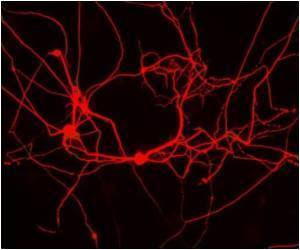
"This is a major breakthrough, because it would otherwise take decades, if not centuries, to map the location of each synapse in the brain and it also makes it so much easier now to build accurate models," says Henry Markram, head of the BBP.
A longstanding neuroscientific mystery has been whether all the neurons grow independently and just take what they get as their branches bump into each other, or are the branches of each neuron specifically guided by chemical signals to find all its target. To solve the mystery, researchers looked in a virtual reconstruction of a cortical microcircuit to see where the branches bumped into each other. To their great surprise, they found that the locations on the model matched that of synapses found in the equivalent real-brain circuit with an accuracy ranging from 75 percent to 95 percent.
This means that neurons grow as independently of each other as physically possible and mostly form synapses at the locations where they randomly bump into each other. A few exceptions were also discovered pointing out special cases where signals are used by neurons to change the statistical connectivity. By taking these exceptions into account, the Blue Brain team can now make a near perfect prediction of the locations of all the synapses formed inside the circuit.
Virtual ReconstructionThe goal of the BBP is to integrate knowledge from all the specialised branches of neuroscience, to derive from it the fundamental principles that govern brain structure and function, and ultimately, to reconstruct the brains of different species – including the human brain – in silico. The current paper provides yet another proof-of-concept for the approach, by demonstrating for the first time that the distribution of synapses or neuronal connections in the mammalian cortex can, to a large extent, be predicted.
To achieve these results, a team from the Blue Brain Project set about virtually reconstructing a cortical microcircuit based on unparalleled data about the geometrical and electrical properties of neurons—data from over nearly 20 years of painstaking experimentation on slices of living brain tissue. Each neuron in the circuit was reconstructed into a 3D model on a powerful Blue Gene supercomputer. About 10,000 of virtual neurons were packed into a 3D space in random positions according to the density and ratio of morphological types found in corresponding living tissue. The researchers then compared the model back to an equivalent brain circuit from a real mammalian brain.
Advertisement
They went on to discover that the synapses positions are only robust as long as the morphology of each neuron is slightly different from each other, explaining another mystery in the brain – why neurons are not all identical in shape. "It's the diversity in the morphology of neurons that makes brain circuits of a particular species basically the same and highly robust," says Hill.
Advertisement
Source-Eurekalert














